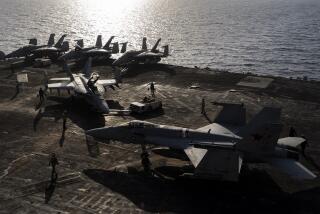Contract Brightens Cloudy Nassco Future : Shipbuilding: Looming defense cuts continue to plague the only remaining shipyard on the West Coast.
A contract to build the third in a series of combat supply ships for the Navy promises to pull San Diego-based National Steel & Shipbuilding Co. out of the red for the first time in two years, but impending defense cuts have put the future of the recently restructured company in jeopardy, executives said Monday.
Although the Navy so far has agreed to buy three of the high-speed fuel and munitions supply ships, there are no guarantees that it will go forward with an option to buy a fourth,said Fred Hallett, Nassco’s chief financial officer.
“Without the (supply ships), we would not have a yard here in San Diego,” Hallett said. “We have until 1993, (when the last of the three ships is expected to be delivered to the Navy), but that obviously doesn’t put us out of the woods yet.”
A management-led buyout in April saved the financially troubled company--the only remaining shipbuilding company on the West Coast--from the fate of 44 other American shipyards forced to close during the past eight years. Putting their personal assets up as collateral, a four-member management group found funding to buy the shipyard from its former owner, Morrison-Knudsen of Boise, Ida., which had planned to sink the shipyard after taking a record $30-million loss in 1988.
The contract for the supply ships--vessels that are designed to keep pace with groups of combat ships at a 25-knot clip while carrying a maximum load of 150,000 barrels of fuel and 1,800 tons of munitions--will keep the company afloat by providing a steady source of revenue and jobs for about 3,100 people, Hallett said.
Pieced together out of 100-ton steel blocks, each 754-foot-long ship takes about three years to build. Each will be manned by a crew of 667.
The first of the three ships, known as AOE-6 (military shorthand for auxiliary oiler explosives ), awaits its maiden voyage from an inclined ways, or framework, where it still must be outfitted with a hull, deck and house. Next in line, AOE-7, lies in unassembled blocks on the shipyard, while work on AOE-8 has yet to begin.
With each supply ship bringing in about $197 million, Nassco executives expect to show a profit in 1989 for the first time in three years, Hallett said. If the Navy exercises its option to buy a fourth and final supply ship next year, Nassco can expect to earn $1 billion in revenue in 1989 dollars, Hallett said.
Still, the company has a long way to go before it equals its former production peak, achieved in 1981, when it delivered four ships in a single year. Under the current Navy contract, Nassco isn’t scheduled to deliver a single ship until the fall of 1991, when the first of the Navy supply ships is expected to be launched. The remaining two are expected to be delivered in 1992 and 1993.
Meanwhile, ship repairs are the only other work keeping Nassco employees busy. Work on the shipyard’s most famous repair job, the damaged Exxon Valdez supertanker, which caused the largest oil spill in U.S. history when it ran aground in Alaska earlier this year, is expected to be completed by summer.
Unlike scores of other American shipyards, Nassco has managed to stay in business despite financial troubles and a worsening shipbuilding climate.
Industry experts tend to blame foreign shipyards, operating with the help of government subsidies, for the downturn in American shipbuilding, as well as the Reagan Administration, which eliminated a domestic subsidy program that allowed U.S. companies to compete with foreign ones.
In the past eight years, the American shipbuilding industry has lost about 34,000 jobs. And none of the 800 or so commercial shipbuilding contracts awarded worldwide last year went to American shipyards, said Patrick Morris, vice president and general counsel for the Shipbuilders Council of America in Washington.
Shipbuilding experts estimate that military contracts now make up about 95% of the U. S. shipbuilding industry, whereas, in 1976, only about half the ships built in the United States were for the military.
With the Soviet Union posing less of a threat and military defense spending cuts sure to follow, those figures are a source of worry to American shipyard executives, who have become ever more hungry for a share of the world’s commercial shipbuilding contracts.
“If the military budget is going to go down, you’re going to have to replace those orders with something else,” Morris said. “We’re trying to create a more hospitable environment in the commercial arena.”
To that end, the Shipbuilding Council filed a petition in June under the 1974 Omnibus Trade Act alleging that Japan, West Germany, Norway and South Korea are all engaged in unfair trading practices. Commerce Department officials, if they agree with the petition’s allegations, may seek sanctions, such as boycotts, against a country found to be in violation of fair trade practices.
“We, in our judgment, conclusively document that they are engaged in subsidy practices, varying from financial scheme to direct subsidies,” Morris said.
A month after filing the petition, however, the council withdrew its request after each country agreed to send trade representatives to the Organization of Economic Cooperation and Development in Paris for negotiations.
If no agreement is reached by March 31, U.S. shipbuilding interests intend to file another petition, Morris said.
Meanwhile, American shipbuilding companies are on the offensive, lobbying for the same public support that won economic sanctions against foreign steel and auto companies believed to be competing unfairly against U.S.-based companies.
A Nassco position paper issued last month stated: “The sight of bulldozers ripping holes in the Berlin Wall is a powerful reminder that America will need to make the transition from a Cold War economy to a more commercially oriented, non-defense economy during the 1990s. For Nassco and the U.S. shipbuilding industry, changes in military strategies and probable cuts in defense budges now and in the future likely will reduce the country’s spending on new U. S. Navy ships.
“Fortunately, there is another worldwide market that is available to Nassco, if we can only open it to fair competition.”
That market is, of course, the commercial market. And its importance to the future of the shipbuilding industry is clear to anyone who wields a blow torch on the dry docks--especially anyone with a stake in a company’s future profits.
Robert Godinez, business manager for the Ironworkers Local 627, representing about 1,100 iron workers at Nassco, said the manager-employee buyout has made the workers more interested in decisions that have an impact on the company. Workers who last year staged a strike to protest scheduled wage cuts are now aligned with managers in the push for a fair and competitive world shipbuilding market.
“We have to look at new construction to stay in business in order to keep food on the table and to keep the guys working,” Godinez said. “We feel we’re not on an even keel (with foreign shipyards.) There’s no way we can win any shipbuilding contracts when we’re up against the foreign countries who subsidize their shipyards.”
More to Read
Inside the business of entertainment
The Wide Shot brings you news, analysis and insights on everything from streaming wars to production — and what it all means for the future.
You may occasionally receive promotional content from the Los Angeles Times.










